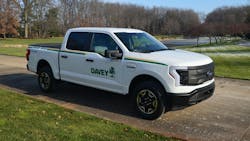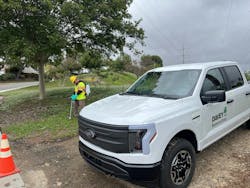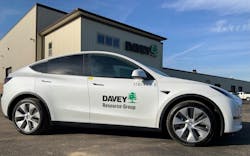Fleet Electrification in the Tree-Care Industry
In less than 10 years, consumers have broken electric vehicle (EV) sales records with no signs of EV sales slowing down. In fact, a Pew Research Center article, “How Americans view electric vehicles,” stated that four out of every 10 Americans are considering or will consider an EV when they purchase their next new vehicle.
But what about commercial fleets? Where are they in the transition to cost-effective, zero-emission horsepower? The race is on that front, too, with fleet electrification powering up across all major markets, including the tree-care industry.
Why Fleet Electrification?
Without a doubt, electrification will continue as the United States strives to reach its net-zero emissions targets in the coming decades. And clean transportation is key to making it happen.
It may seem that nearly everyone is adding electric trucks to their fleet and here’s why:
Commercial trucks (and buses) are among the biggest contributors to greenhouse gases (GHGs), accounting for 25 percent of transportation-sector GHGs, stated the Environmental Defense Fund report, “The Road to Zero Emission Trucks,” — and that’s despite the fact that trucks and buses account for only 4% of on-the-road vehicles.
While accelerating the conversion of a transportation fleet from gasoline-powered to electric is good environmentally, successfully making the transition requires more than a commitment to sustainability; it requires a forward-looking business model and a smart strategy for implementation.
Testing EVs in a Pilot Project
Throughout its 140-year history, Davey Tree has been synonymous with environmental awareness and stewardship. To hold itself accountable in managing and mitigating impacts on the environment — and helping its clients do likewise — Davey is working hard to stay ahead of the EV curve. Here’s a look at how the company is applying innovation and problem-solving to achieve greater efficiencies and fewer emissions.
Challenge: “We didn’t want to wait for mandates requiring the use of EV and electric tools to drive our transition,” says Paul Milano, Davey’s vice president, fleet services and procurement, “so we’ve been continually looking for ways to get the best of both worlds: high fuel economy and reduced reliance on fossil fuels.”
Solution: In addition to including Tesla Model Y electric cars in its vegetation management fleet, Davey recently added a mini fleet of Ford F-150 Lightnings. These all-electric trucks, which are part of a pilot program to assess the value of incorporating more EV trucks into the company’s business operations, are being used in all Davey service lines. For example, Davey Resource Group, a subsidiary of Davey, and a Utility Vegetation Management (UVM) services team are using these EV trucks for tree growth regulators (TGR).
Results: Although the results of this pilot program won’t be available until late 2024, Davey is already using preliminary data to determine the best way to incorporate more EVs into its fleet. In addition to the all-electric trucks, Davey’s fleet also includes more than 1,000 hybrid and alternative fuel vehicles, such as the Toyota Rav4 LE Hybrid SUV and Ford F-150 Flex Fuel vehicles. This mix of hybrid, electric and alternative fuel vehicles comprise about one-eighth of Davey’s total fleet and is already helping the organization reduce reliance on fuel while also lowering the company’s carbon footprint.
Weighing the Pros and Cons of EVs
Like all early adoption technologies, Davey has uncovered both the pros and cons of EVs in a commercial fleet. Here’s a high-level look at what the company has discovered.
Pros
- EVs can help reduce carbon footprints. According to the U.S. Department of Energy report, “Emissions from Electric Vehicles,” all-electric vehicles, hybrid vehicles and hybrid-electric vehicles produce lower tail pipe emissions than gasoline-powered vehicles and zero emissions when operating exclusively on electricity.
- EVs can be more cost effective. In addition to the obvious fuel savings, EV maintenance costs are typically lower too.
- EVs and electric-battery powered tools reduce noise pollution. Without a gas-powered motor, EVs and battery-powered tools, such as electric mowers and trimmers, don’t generate the buzz, whine and noise of traditional vehicles and equipment. Even better, having fewer noise emissions is a happy byproduct for residents, owners, visitors and tenants of commercial grounds properties, including hospitals, college campuses, military bases and Homeowners Associations (HOAs).
- EVs can help reduce fire hazards. Unlike traditional combustion engines, which have many hot points of contact that can become a fire hazard, EVs and electric equipment don’t have those issues. Also, during certain weather events, such as red flag warnings, clean energy can still be used, whereas the use of traditional fuel-powered vehicles and equipment may be restricted.
Cons
- EV charging infrastructure is insufficient. Although EV charging stations are popping up in more and more locations, the lack of adequate charging stations is a major challenge. According to consulting firm Deloitte, in its article titled, “Climbing the electric vehicle transformation mountain,” the United States continues to lack “an efficient, affordable, and reliable EV charging network” with only 32,000 available public DC fast chargers. “Charging is the biggest hurdle for us right now,” explains Milano. “We have to be strategic in how we manage the charging issue. Our crews don’t want to sit for hours at a time without being productive, so we scout out fast-charge locations and do typical work-in-the-truck tasks to make the most of it.”
- Cold weather may negatively affect EV performance. While no conclusive studies prove that EVs are useless when subjected to severe temperatures, enough anecdotal evidence suggests that lower temperatures are likely to affect EV battery performance, including capacity, range and charging times. “Our Teslas have been flawless through the cold weather, but winter 2023 was the first season with our all-electric Ford Lightnings. We’re optimistic, of course, but we’ll have
to see what they can do in the cold,” says Milano.
Planning ahead is a must. Charging an electric vehicle takes longer than pumping gasoline into a vehicle’s tank, which begs the question, “Is the vehicle capable of doing what’s needed when it’s needed?” Charging an EV can take anywhere from 30 minutes on a fast charge to several hours or even overnight. For fleet managers and EV operators, this means optimizing the route, includingknowing where and what kinds of charging stations are available.
Are You Doing the Right Thing?
While the transition from a gas-powered fleet to an electric fleet is neither simple nor easy, it is the right thing to do. The key is being thoughtful and strategic about the transition. In addition to using what you’ve learned here, start by assessing your own sustainability goals. Talk to others about what their sustainability programs look like and look for ways to partner and mutually support your vendors and service providers in their sustainability goals. Because, in the end, it’s going to take a village to reach our national goal of net zero emissions by 2050 — but it will be worth it.
Six Fleet Electrification Do’s and Don’ts
As one of the top 25 of green fleets of all commercial fleets in the United States, Davey has learned a thing or two about transitioning to electric vehicles. Here are some of Davey’s top tips based on the successes the organization has in electrifying its commercial fleet.
1. DO set goals. The transition to electric is a significant one that’s not without an investment of time, energy and budget. In addition to determining a strategy, organizations will also want definitive metrics, milestone and outcomes so they can monitor their progress and measure their outcomes. As an example, in 2017, Davey established a bold goal to reduce its global fleet fuel consumption by 35 percent per labor hour by 2023 from a 2017 baseline. Through 2022, Davey reduced its fuel use per labor hour by 21%, thanks to a consolidated increase in labor hours and innovative solutions, such as the introduction and expansion of battery-operated tools, EV/hybrid technologies and the right sizing of the fleet.
2. DON’T be afraid to go slow. Rather than revamping the entire fleet in one fell swoop, smart managers will test different variables on a small scale. For Davey, this meant introducing just a few EVs into the fleet and measuring their performance across different service lines and climates.
3. DO develop a custom fleet electrification strategy. Every organization is unique so it’s important for organizations to assess where they are before deciding where they want to go. Davey’s conversion plan takes into consideration not only field operations but also need and potential impact.
4. DON’T forget there’s a learning curve. “Nobody has it all figured out,” says Milano. “We’re still in the learning curve stage, but we’re being aggressive, knowing that we’re helping shape and influence the future of electrification in our industry.” With that in mind, Milano encourages others to learn all they can about electrification, as well as follow current best practices.
5. DO plan ahead. Because one of the cons of EVs is the time it takes to charge the vehicle, it’s essential to think ahead on how to maximize the workday. The solution is to designate “admin time” for phone calls and computer work while parked at a charging station.
6. DON’T neglect ancillary sustainability reporting. While most organizations regularly document their progress toward environmental, social and governance (ESG) goals, Milano urges them to tie their environmental goals to their vendors’ efforts. For example, Davey’s fleet electrification efforts are reported by both Davey and its utility customers. If you’re not familiar with your vendor’s ESG goals and outcomes, just ask.
About the Author
Jill Golden
Jill Golden ([email protected]) is a project manager in corporate communications for The Davey Tree Expert Company, which offers UVM and IVM services as well as tree, lawn care and environmental consulting services throughout the United States and Canada. Golden earned her bachelor’s degree in public relations from Kent State University in Kent, Ohio.


